ATV NVR04P21T, NVR04P22T, NVR04P24T, NVR04P26T, NVR08P212T User Manual
...User Manual
4/8/16/32Ch NVR (Network Video Recorder)
Please read this manual thoroughly before use and keep it handy for future reference.

WARNING
TO REDUCE THE RISK OF FIRE OR ELECTRIC SHOCK, DO NOT EXPOSE THIS PRODUCT TO RAIN OR MOISTURE. DO NOT INSERT ANY METALLIC OBJECT THROUGH THE VENTILATION GRILLS OR OTHER OPENNINGS ON THE EQUIPMENT.
CAUTION
CAUTION
RISK OF ELECTRIC SHOCK
DO NOT OPEN
WARNING: TO REDUCE THE RISK OF ELECTRIC SHOCK,
DO NOT REMOVE COVER (OR BACK).
NO USER-SERVICABLE PARTS INSIDE.
REFER SERVICING TO QUALIFIED SERVICE PERSONNEL
EXPLANATION OF GRAPHICAL SYMBOLS
The lightning flash with arrowhead symbol, within an equilateral triangle, is intended to alert the user to the presence of dangerous voltage within the products enclosure that may be of sufficient magnitude to constitute a risk of electric shock to persons.
The exclamation point within an equilateral triangle is intended to alert the user to the presence of important operating and maintenance (servicing) instructions in the literature accompanying theproduct.
3

FCC COMPLIANCE STATEMENT
This device complies with Part 15 of the FCC Rules. Operation is subject to the following two conditions: (1) this device may not cause harmful interference, and (2) this device must accept any interference received, including interference that may cause undesired operation.
FCC INFORMATION: This equipment has been tested and found to comply with the limits for a Class A digital device, pursuant to Part 15 of the FCC Rules. These limits are designed to provide reasonable protection against harmful interference when the equipment is operated in a commercial environment. This equipment generates, uses, and can radiate radio frequency energy and, if not installed and used in accordance with the instruction manual, may cause harmful interference to radio communications. Operation of this equipment in a residential area is likely to cause harmful interference in which case the user will be required to correct the interference at his own expense.
CAUTION: Changes or modifications not expressly approved by the party responsible for compliance could void the user’s authority to operate the equipment.
This Class A digital apparatus complies with Canadian ICES-003.
Cet appareil nume`rique de la classe A est conforme a´ la norme NMB-003 du Canada.
CE COMPLIANCE STATEMENT
WARNING
This is a Class A product. In a domestic environment this product may cause radio interference in which case the user may be required to take adequate measures.
CAUTION
RISK OF EXPLOSION IF BATTERY IS REPLACED BY AN INCORRECT TYPE. DISPOSE OF USED BATTERIES ACCORDING TO THE INSTRUCTIONS.
4

IMPORTANT SAFETY INSTRUCTIONS
1.Read these instructions.
2.Keep these instructions.
3.Heed all warnings.
4.Follow all instructions.
5.Do not use this apparatus near water.
6.Clean only with dry cloth.
7.Do not block any ventilation openings. Install in accordance with the manufacturer’s instructions.
8.Do not install near any heat sources such as radiators, heat registers, stoves, or other apparatus (including amplifiers) that produce heat.
9.Do not defeat the safety purpose of the polarized or grounding-type plug. A polarized plug has two blades with one wider than the other. A grounding type plug has two blades and a third grounding prong. The wide blade or the third prong is provided for your safety. If the provided plug does not fit into your outlet, consult an electrician for replacement of the obsolete outlet.
10.Protect the power cord from being walked on or pinched particularly at plugs, convenience receptacles, and the point where they exit from the apparatus.
11.Only use attachments/accessories specified by the manufacturer.
12.Use only with the cart, stand, tripod, bracket, or table specified by the manufacturer, or sold with the apparatus. When a cart is used, use caution when moving the cart/apparatus combination to avoid injury from tip-over.
13.Unplug this apparatus during lightning storms or when unused for long periods of time.
14.Refer all servicing to qualified service personnel. Servicing is
required when the apparatus has been damaged in any way, such as power-supply cord or plug is damaged, liquid has been spilled or objects have fallen into the apparatus, the apparatus has been exposed to rain or moisture, does not operate normally, or has been dropped.
15.CAUTION – THESE SERVICING INSTRUCTIONS ARE FOR USE BY QUALIFIED SERVICE PERSONNEL ONLY. TO REDUCE THE RISK OF ELECTRIC SHOCK DO NOT PERFORM ANY SERVICING OTHER THAN THAT CONTAINED IN THE OPERATING INSTRUCTIONS UNLESS YOU ARE QUALIFIED TO DO SO.
16.Use satisfy clause 2.5 of IEC60950-1/UL60950-1 or Certified/Listed Class 2 power source only.
17.ITE is to be connected only to PoE networks without routing to the outside plant.
5

Table of Contents
Table of Contents................................................................................................................................. |
1 |
1. |
Overview |
|
3 |
|
|
1.1 |
Package Contents ...................................................................................................................... |
4 |
|
|
1.2 |
NVR Description ......................................................................................................................... |
4 |
|
2. |
Installation |
|
7 |
|
|
2.1 |
Installing HDD ........................................................................................................................... |
8 |
|
|
2.2 |
Connecting with Exterior Device .................................................................................................. |
8 |
|
|
2.3 |
Starting System ....................................................................................................................... |
10 |
|
|
2.4 |
Quick Setup............................................................................................................................. |
11 |
|
|
|
2.4.1 |
Account ...................................................................................................................... |
11 |
|
|
2.4.2 |
System ....................................................................................................................... |
12 |
|
|
2.4.3 |
Network ..................................................................................................................... |
13 |
|
|
2.4.4 |
Time/Date .................................................................................................................. |
13 |
|
|
2.4.5 |
Easy Installation Wizard ............................................................................................... |
14 |
3. |
Live Screen Configuration |
15 |
||
|
3.1 |
Icons in Live screen.................................................................................................................. |
16 |
|
|
3.2 |
Live Launcher menu ................................................................................................................. |
18 |
|
|
|
3.2.1 |
Backup ....................................................................................................................... |
19 |
|
3.3 |
Quick menu ............................................................................................................................. |
21 |
|
|
|
3.3.1 |
PTZ Control ................................................................................................................ |
23 |
|
|
3.3.2 |
Camera Registration .................................................................................................... |
24 |
|
|
3.3.3 |
Status > System log .................................................................................................... |
25 |
|
|
3.3.4 |
Status > Event ............................................................................................................ |
27 |
|
|
3.3.5 |
Status > Record .......................................................................................................... |
28 |
|
|
3.3.6 |
Status > Disk .............................................................................................................. |
29 |
4. |
Setup menu |
|
30 |
|
|
|
|
|
|
|
4.1 |
General buttons in Setup menu ................................................................................................. |
32 |
|
|
4.2 |
SYSTEM |
.................................................................................................................................. |
33 |
|
|
4.2.1 ....................................................................................................................... |
System |
33 |
|
|
4.2.2 .................................................................................................................. |
Time/Date |
35 |
|
|
4.2.3 ........................................................................................................... |
Account > User |
38 |
|
|
4.2.4 ................................................................................................. |
Config (Configuration) |
40 |
|
4.3 |
CAMERA |
.................................................................................................................................. |
42 |
|
|
4.3.1 .......................................................................................................................... |
Basic |
42 |
|
|
4.3.2 ................................................................................................................... |
Advanced |
45 |
|
|
4.3.3 ................................................................................................................ |
Registration |
51 |
|
4.4 |
DEVICE ................................................................................................................................... |
|
53 |
|
|
4.4.1 ....................................................................................................................... |
Display |
53 |
|
|
4.4.2 .............................................................................................................. |
Disk > Setup |
57 |
|
|
4.4.3 ................................................................................................................. |
PTZ > PTZ |
60 |
|
|
4.4.4 ........................................................................................ |
Serial Device > Serial Device |
61 |
|
|
4.4.5 ............................................................................................................. |
TEXT > TEXT |
62 |
|
4.5 |
RECORD.................................................................................................................................. |
|
64 |
|
|
4.5.1 ................................................................................................... |
Schedule > Schedule |
64 |
|
|
4.5.2 ....................................................................................................................... |
Stream |
67 |
|
4.6 |
EVENT .................................................................................................................................... |
|
71 |
|
|
4.6.1 ............................................................................................................... |
System/Disk |
71 |
|
|
4.6.2 ..................................................................................................................... |
Alarm In |
73 |
|
|
4.6.3 ....................................................................................................................... |
Motion |
76 |
|
|
4.6.4 ..................................................................................................... |
Video Loss > Setup |
78 |
|
|
4.6.5 ................................................................................................................. |
Notification |
79 |
|
4.7 |
NETWORK ............................................................................................................................... |
81 |
|
|
|
4.7.1 .......................................................................................................................... |
Basic |
81 |
|
|
4.7.2 ............................................................................................................. |
DVRNS/DDNS |
84 |
|
|
4.7.3 ........................................................................................................................ |
E - Mail |
86 |
|
|
4.7.4 ............................................................................................................................ |
FTP |
87 |
|
|
4.7.5 ......................................................................................................................... |
Warp |
88 |
|
|
4.7.6 ............................................................................................................................ |
P2P |
90 |
|
|
4.7.7 ....................................................................................................... |
Notification Server |
91 |
5. |
Search/Playback |
94 |
||
|
5.1 |
Search .................................................................................................................................... |
|
94 |
|
5.2 |
Playback................................................................................................................................ |
|
100 |
6. |
Webviewer |
|
102 |
|
7. |
Appendix |
|
106 |
|
|
|
|
|
|
|
7.1 |
Installing System Keyboard ..................................................................................................... |
106 |
|
|
7.2 |
Product Specification .............................................................................................................. |
111 |
|

1.Overview
This chapter describes NVR overview, components and their terms and features.
This manual introduces a network video recorder (NVR) which monitors or record, controls images via a network camera.
Multiple users may monitor video at the same time, and many cameras can be controlled simultaneously by a manager. Also, through a PC or a smartphone, video might be monitored by transmitting video and audio using a network.
The device features include the following:
Convenient UI from user’s viewpoint
IP camera input 4/8/16/32 channels
Providing H.264 and H.265 compression
Up to 4K real time recording
HDD information and status presentation
HDD overwriting
High capacity back-up with USB 3.0
Simultaneous recoding and playing of 4/8/16/32 channels
Various search mode (time, event, thumbnail, smart search, text and VCA)
Various recording mode (manual, event, timed recording, panic recording)
Remote monitoring through a network viewer, a web viewer, and a mobile viewer
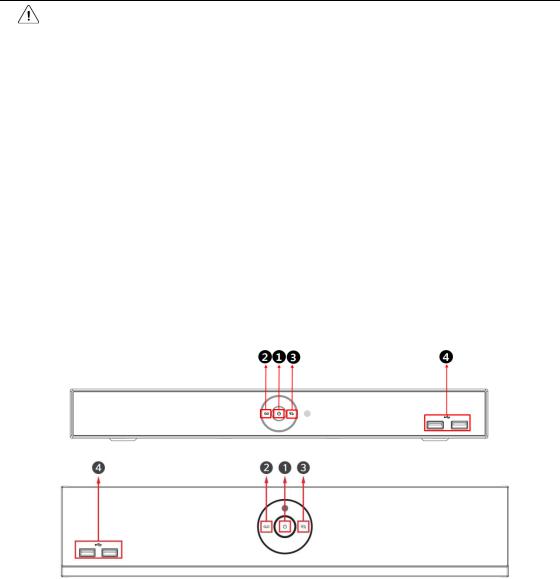
1.1Package Contents
The device package contents consist of the following:
|
|
Note |
Please check all components involved. |
|
|
||
|
|
|
|
|
|
|
|
|
|
|
|
Table 1-1 Package contents |
|
||
|
|
|
|
|
|
|
|
|
No. |
|
Name |
|
No. |
Name |
|
|
|
|
|
|
|
|
|
|
1 |
NVR |
|
|
2 |
DC Adapter(4/8ch only) |
|
|
|
|
|
|
|
|
|
|
3 |
Power cord |
|
|
4 |
Mouse |
|
|
|
|
|
|
|
|
|
|
5 |
SATA cable |
|
|
6 |
SATA power cable |
|
|
|
|
|
|
|
|
|
|
7 |
HDD fixing screw |
|
8 |
Rack mount bracket & screws |
|
|
|
|
|
|
|
|
|
|
|
9 |
Program CD |
|
10 |
Quick guide(This document) |
|
|
|
|
|
|
|
|
|
|
1.2NVR Description
Each part is listed in the below:
Figure 1-1 Name and Connection of each front section
Table 1-2 Name and Function of each front section
No. |
|
Name |
|
Function |
|
|
|
|
|
1 |
|
Power status LED |
|
Pointing out device on/off. |
|
|
|
|
|
2 |
|
Recording status |
|
Pointing out recording in process. |
|
|
LED |
|
|
|
|
|
|
|
|
|
|
|
|
3 |
|
Network LED |
|
With a network viewer, pointing out network in connection. |
|
|
|
|
|
4 |
|
USB port |
|
USB port is connected for USB mouse or firmware upgrade, and data |
|
|
back-up. |
||
|
|
|
|
|
|
|
|
|
|
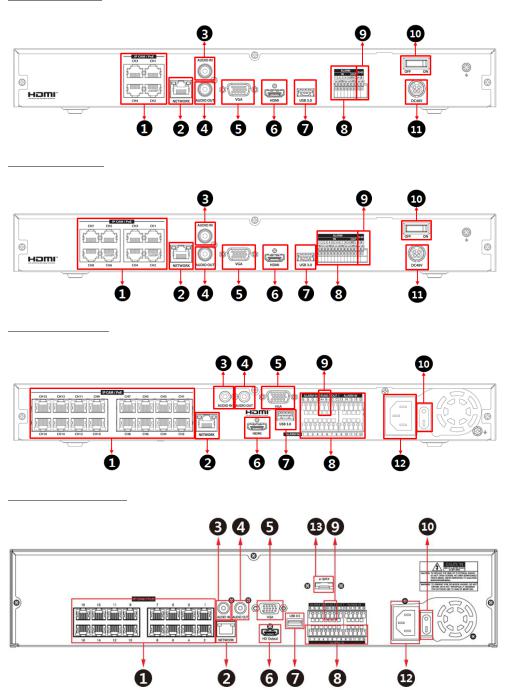
4CH NVR(2HDDs)
8CH NVR(2HDDS)
16CH NVR(2HDDs)
16/32CH NVR(4HDDs)
Figure 1-2 Name and Connection of rear section of 4ch, 8ch and 16ch NVR
Table 1-3 Name and Function of rear section of 4ch, 8ch and 16ch NVR
No. |
Name |
Function |
|
|
|
1 |
IP CAM / PoE |
IP camera input port, IEEE802.3at PoE support. |
|
|
|
2 |
Network |
Network connector. |
|
|
|
3 |
Audio In |
Audio input port. |
|
|
|
4 |
Audio Out |
Audio output port. |
|
|
|
5 |
VGA |
VGA output port. |
|
|
|
6 |
HDMI |
HDMI output port. |
|
|
|
7 |
USB 3.0 |
USB 3.0 port is connected for data back-up. |
|
|
|
8 |
Alarm In/Out |
Alarm connector. |
|
|
|
9 |
RS485 |
RS-485 communication connector. |
|
|
|
10 |
Power Switch |
Power On-Off. |
|
|
|
11 |
DC48V |
DC adapter input port. |
|
|
|
12 |
AC POWER INPUT |
AC Power cord input port. |
|
|
|
13 |
e-SATA |
e-SATA storage connection connector. |
|
|
|
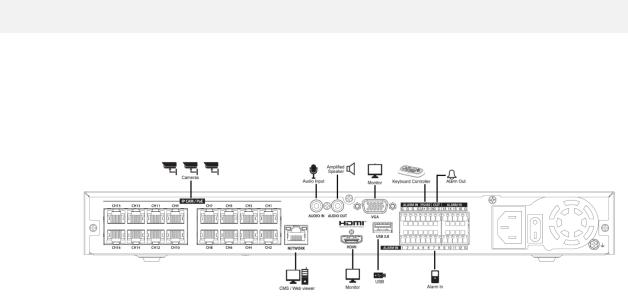
2.Installation
This chapter describes the way to install NVR.
When installing a device, connect rear of the device with each port on the basis of below connection map.
Figure 2-1 Connection map
The device starts first like below sequences:
1Installing HDD
2Connecting with an exterior device
3Starting a system
4Setting a quick setup

2.1Installing HDD
How to install HDD in the device:
|
|
Withdraw the main plug before installing HDD to reduce the risk of injury or |
Attention |
|
electrical shock, or device malfunction. |
|
Make sure to check the compatibility of HDD with the device. |
|
|
|
|
1Always switch off and unplug the unit.
2Unscrew with a screw driver (+) and open the unit cover.
3Unscrew HDD set screws of the bracket to disassemble.
4Install HDD in the bottom case.
5Fix the HDD-installed bracket with the unit.
6Connect a data cable and power cable with HDD.
7Close the cover and tighten screws.
2.2Connecting with Exterior Device
How to connect each port to rear section of the unit:
1Place the unit in a stable flat surface.
2Make a room between front/rear sides of the device not to break connectors.
|
Do NOT install the device too close to the wall. Protrusive connects rear the unit |
Warning |
may be forcedly curved or pressed, which cause fires, electric shocks, or injury. |
|
|
3 Check to switch off and unplug the unit.
Warning |
Make sure to withdraw the mains plug before installing the device. |
|
|
|
|
4 Connect input ports of IP camera .
Note Connecting a camera port with the unit automatically detects the camera.
5 Connect audio input and output port with a mic and speaker.
Note Assure regulations in the area whether recording to be legal or not.

6Connect a monitor with VGA or HDDMI port.
7Connect a network port.
8Connect an alarm and RS485 device.
9Connect an e-SATA storage(4HDD model only).
10Connect USB port for data back-up.
11Supply the main power after completion.
Power Switch
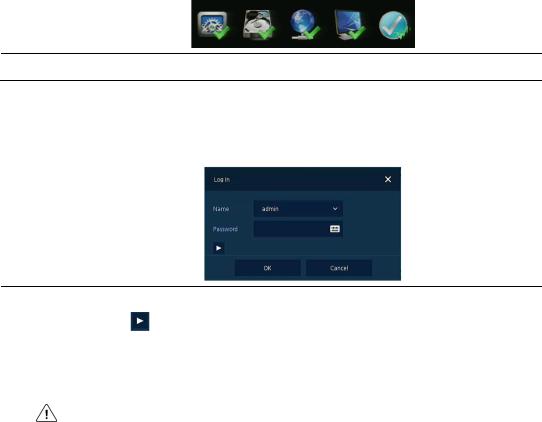
2.3Starting System
Power supply begins with system operation as follows:
1 Switching on initialize with below icons in order.
Note Installing new HDD might take more initialize time.
2With buzzer sounds, the start screen is presented.
3In Log in screen, enter the ID, Password and press OK.
|
Default ID & Password is admin/admin. |
|
Note |
Click |
to see the MAC address. |
|
|
|
|
If lost password, inform the MAC address to supplier to create temporary |
|
|
password. |
|
|
|
|
|
|
|
|
Default password must be changed at the Quick Setup – Account menu due to |
|
Attention |
security. |
|
|
|
|
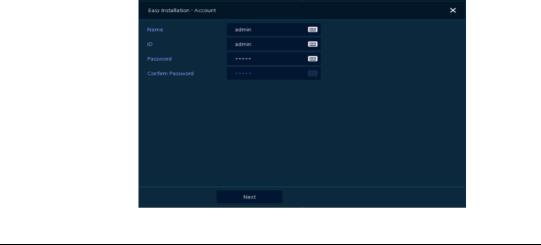
2.4Quick Setup
First start of the system operates Easy Installation as follows:
1Account
2System
3Network
4Time/Date
5Easy Installation Wizard
2.4.1Account
How to set Account of Easy Installation:
1 Click the keyboard icon to set ID and Password users want.
2 With keyboard UI, set the ID and Password, and press OK.
|
Default ID/Password is admin/admin. |
|
Note |
|
The default password must be changed for security. |
|
|
Max character length is 12. |
|
|
|
3 Enter new password.
A password can be used if it satisfies two or more in the following criteria:
1)It contains at least one lowercase English character.
2)It contains at least one uppercase English character.
3)It contains at least one special character. The special characters are “! @ # $ % ^ & * ( ) - + ...”
4)It contains at least one digit.
Its length must be at least 10 if it satisfies only two of the above criteria.
Its length must be at least 8 if it satisfies three or more of the above criteria.
4 Press Next button to end Account setting and move the next setting phase.
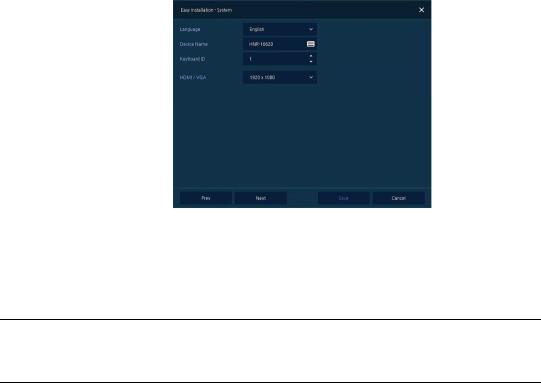
2.4.2System
How to set the system of Easy Installation:
1 Set each item in System setting screen.
Language: Select system language.
Device Name: Enter the device name.
Keyboard ID: To identify device usages in controlling NVR with RS485 through a keyboard
Selecting the device ID. In case of simultaneous use of equipment, set ID with difference.
Note |
As for using many NVRs, set ID with difference. |
|
|
HDMI/VGA: Set resolution of a monitor connected to the device.
|
|
Video is not displayed through VGA port if set 3840x2160 resolution. |
Note |
|
If resolution is set to 3840x2160 and a monitor that does not support this |
|
resolution is connected to the HDMI port, it will automatically change to |
|
|
|
|
|
|
1024x768 resolution. |
|
|
|
2Press Save button to save set value.
3Press Next to end System setting and move the next setting phase.
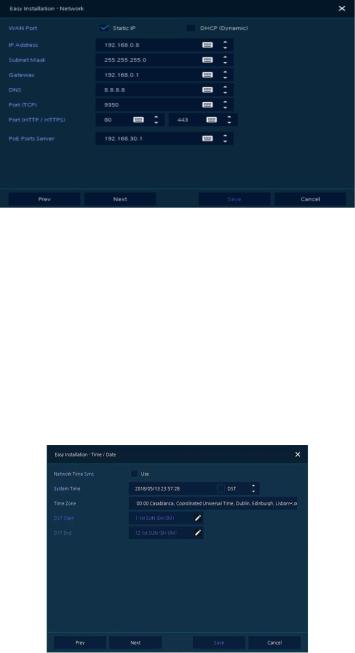
2.4.3Network
How to set the network of Easy Installation:
1 Set each item in Network setting screen.
WAN Port: Select whether to use static IP or dynamic IP.
IP Address, Subnet Mask, Gateway, DNS, and Port: As for dynamic IP, enter information in each space.
2Press Save button to save set value.
3Press Next to end Network setting and move the next setting phase.
2.4.4Time/Date
How to set the time/date of Easy Installation:
1 Set each item in Time/Date setting screen.
Network Time Sync: Select network for synchronizing with time server.
System Time: Not for synchronizing with network time server, set the device time; otherwise (applying for Daylight saving time), select DST.
Time Zone: Select time zone for the system being installed.
DST Start/End: For applying Daylight saving time, set the application period.
2Press Save button to save set value.
3Press Next to end Time/Date setting and move the next setting phase.
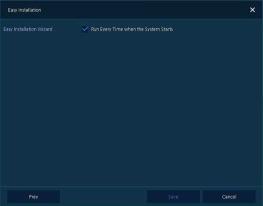
2.4.5Easy Installation Wizard
1Select to run Easy Installation every time when the system start.
2Press Save button to save set value and end Easy Installation.

3.Live Screen Configuration
UI screen is configured like below figure.
|
|
|
|
Figure 3-1 UI Screen Configuration |
|
|
Table 3-1 Items and Description of UI Screen Configuration |
||
|
|
|
|
|
No. |
|
Item |
|
Description |
|
|
|
|
|
1 |
|
Setup menu |
|
Setting menu is located in the corner of upper screen. See “4 Setup |
|
|
menu” to display detailed information about the setting menu. |
||
|
|
|
|
|
|
|
|
|
|
2 |
|
Live screen |
|
Show live video of connected cameras. |
|
|
|
|
|
|
|
|
|
Launcher menu is located in the corner of below screen. See “3.2 Live |
3 |
|
Launcher menu |
|
Launcher menu” to display detailed information about the launcher |
|
|
|
|
menu. |
|
|
|
|
|
4 |
|
Quick menu |
|
Clicking the right button of a mouse displays Quick menu. See “3.3 |
|
|
Quick menu” to display detailed information about the quick menu. |
||
|
|
|
|
|
|
|
|
|
|
|
|
|
|
Move mouse cursor on the center of window to register IP camera |
5 |
|
Add to CH |
|
manually. See”3.3.2 Camera Registration” to display detailed |
|
|
|
|
information about the camera registration. |
|
|
|
|
|
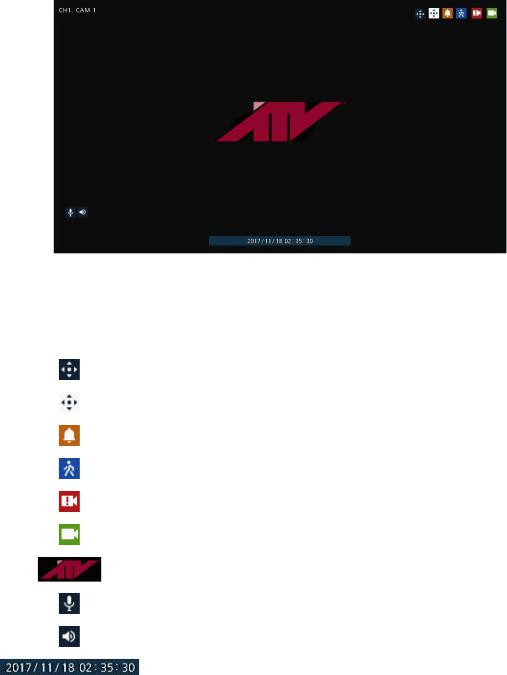
3.1Icons in Live screen
Each icon in the live screen displays a present setting status or a function. UI screen consists of like below.
|
|
Figure 3-2 Live screen icon |
|
|
Table 3-2 Live screen icon and its description |
|
|
|
No. |
Icon |
Description |
|
|
|
1 |
CH1 CAM1 |
Channel numbers and camera titles. |
|
|
|
2 |
|
A camera with PTZ function. |
|
|
|
3 |
|
PTZ control function in process. |
|
|
|
4 |
|
Recording in alarm event mode. |
|
|
|
5 |
|
Recording in motion event mode. |
|
|
|
6 |
|
Recording in panic recording mode. |
|
|
|
7 |
|
Recording in consecutive recording mode. |
|
|
|
8 |
|
Video loss icon. |
|
|
|
9 |
|
Mic on/off. |
|
|
|
10 |
|
Speaker on/off. |
|
|
|
11 |
|
Displaying present time and date. |
|
|
|
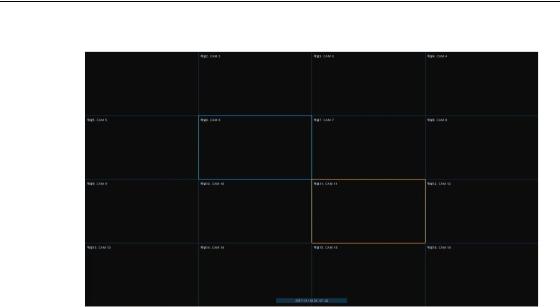
Note |
Chosen live screen is marked as a blue frame; mouse-located live screen is marked |
|
as yellow one. |
||
|
||
|
|
Figure 3-3 Chosen live screen channel

3.2Live Launcher menu
This chapter describes Launcher menu in the bottom of the screen.
|
|
|
Figure 3-4 Launcher menu |
|
|
|
Table 3-3 Launcher menu Item and Description |
|
|
|
|
No. |
Item |
|
Description |
|
|
|
|
1 |
|
|
Log in/out status and logged in ID. |
|
|
|
|
2 |
Date & Time |
|
Displaying present date and time. |
|
|
|
|
3 |
HDD |
|
Displaying HDD capacity in use. |
|
|
|
|
4 |
|
|
Moving to previous/next partition screen. |
|
|
|
|
5 |
|
|
Displaying live screen in order set (toggle). |
|
|
|
|
6 |
|
|
Selecting partition mode to mark in live screen (single screen, 4-, 9-, and 16- |
|
|
partition). |
|
|
|
|
|
|
|
|
|
7 |
|
|
Stopping or replaying selected live screen images (toggle). |
|
|
|
|
8 |
|
|
Audio on or mute chosen live screen(toggle). |
|
|
|
|
9 |
|
|
Instant recording for 10 seconds. |
|
|
|
|
10 |
|
|
Make a backup video of users want. See “3.2.1 Backup” to display detailed |
|
|
information about back-up. |
|
|
|
|
|
|
|
|
|
|
|
|
Searching recording data (time, event, thumbnail, smart search, text and VCA). |
11 |
|
|
See “0 |
|
|
|
Search” to display detailed information about search. |
|
|
|
|
12 |
|
|
Playback recorded data. |
|
|
|
|
13 |
|
|
Starting immediate recording of selected channel. |
|
|
|
|
14 |
|
|
Locking or releasing launcher menu (toggle). |
|
|
|
|
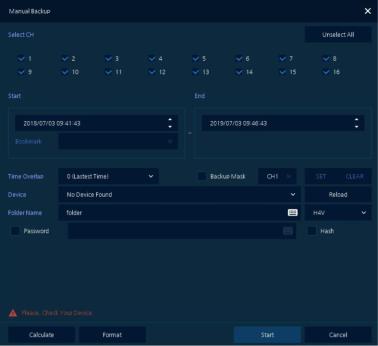
3.2.1Backup
The device provides a back-up function of live screen.
|
|
|
|
Figure 3-5 Backup |
|
|
|
|
Table 3-4 Backup Item and Description |
|
|
|
|
|
No. |
|
Item |
|
Description |
|
|
|
|
|
1 |
|
Select CH |
|
Selecting a channel users want to back-up. |
|
|
|
|
|
2 |
|
Select All/ |
|
Select or clear all channels. |
|
Unselect All |
|
||
|
|
|
|
|
|
|
|
|
|
3 |
|
Start |
|
Setting back-up start time (Bookmark: bookmark list). |
|
|
|
|
|
4 |
|
End |
|
Setting back-up ending time (Bookmark: bookmark list). |
|
|
|
|
|
5 |
|
Time Overlap |
|
Selecting time if there are two recorded data in the same time. |
|
|
|
|
|
6 |
|
Backup Mask |
|
User can mask selected area. It works H4V format only. |
|
|
|
|
|
7 |
|
Device |
|
Selecting the device to save back-up files. |
|
|
|
|
|
8 |
|
Reload |
|
Opening the device information. |
|
|
|
|
|
9 |
|
Folder Name |
|
Entering a folder name to save back-up files. |
|
|
|
|
|
10 |
|
File format |
|
Selecting a file format to back-up(H4V / AVI) |
|
|
|
|
|
11 |
|
Password |
|
If back-up file format is H4V, user can set password for security. |
|
|
|
|
|
12 |
|
Hash |
|
Insert Hash information into the backup file. It support H4V format only. |
|
|
The hash information can be used to verify the forgery of the backup file. |
||
|
|
|
|
|
|
|
|
|
|
13 |
|
Calculate |
|
Calculating data capacity to back-up. |
|
|
|
|
|
14 |
|
Format |
|
Formatting the device to back-up. |
|
|
|
|
|
15 |
|
Start |
|
Starting back-up. |
|
|
|
|
|
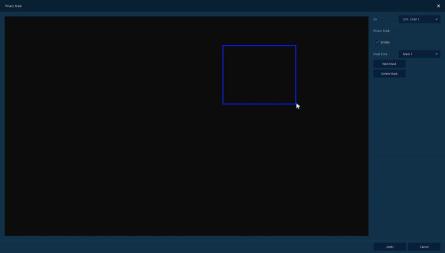
No. |
Item |
Description |
|
|
|
16 |
Cancel |
Closing the backup screen. |
|
|
|
Select Backup Mask and click SET button to open the Privacy Mask pop-up window.
|
|
|
|
Figure 3-6 Backup Mask |
|
|
|
|
Table 3-5 Backup Mask Item and Description |
|
|
|
|
|
No. |
|
Item |
|
Description |
|
|
|
|
|
1 |
|
Select CH |
|
Select the channel to set the privacy zone. |
|
|
|
|
|
2 |
|
Privacy Mask |
|
Select whether to use the Privacy Mask. |
|
Enable |
|
||
|
|
|
|
|
|
|
|
|
|
3 |
|
Mask Zone |
|
Apply all or only the selected mask. |
|
|
|
|
|
4 |
|
New Mask |
|
Create a new privacy zone. Up to 4 masks can be created. |
|
|
|
|
|
5 |
|
Delete Mask |
|
Delete all or selected privacy zones. |
|
|
|
|
|
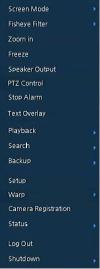
3.3Quick menu
This chapter depicts Quick menu when users click the right button of the mouse in live screen.
|
|
|
|
Figure 3-7 Quick menu |
|
|
|
|
Table 3-6 Quick menu Item and Description |
|
|
|
|
|
No. |
|
Item |
|
Description |
|
|
|
|
|
1 |
|
Screen Mode |
|
Selecting the partition mode of live screen (Full, 2X2, 3X3, and 4x4). |
|
|
|
|
|
2 |
|
Fisheye View |
|
Selecting Fisheye view mode. This menu is shown when fisheye camera |
|
Mode |
|
connected. |
|
|
|
|
||
|
|
|
|
|
3 |
|
Zoom in |
|
Magnifying selected live screen (Zoom out, 2 times, 4 times, and 8 times). |
|
|
This menu is shown full screen mode only. |
||
|
|
|
|
|
|
|
|
|
|
4 |
|
Freeze |
|
Freezes the video selected live screen images (toggle on / off). |
|
|
|
|
|
5 |
|
Speaker |
|
Turning on/off a sound speaker. |
|
Output/Mute |
|
||
|
|
|
|
|
|
|
|
|
|
6 |
|
PTZ Control |
|
Controlling PTZ function. This menu is shown when PTZ camera |
|
|
connected. |
||
|
|
|
|
|
|
|
|
|
|
7 |
|
Stop Alarm |
|
Stopping monitoring alarm output and event. |
|
|
|
|
|
8 |
|
Text Overlay |
|
POS text overlayed on the screen. This menu is show when enable Text |
|
|
menu. |
||
|
|
|
|
|
|
|
|
|
|
9 |
|
Playback |
|
Playing selected live screen images (before 30 sec, 1 min, 5 min, 10 min, |
|
|
30 min, 1-hour, Go to last play time, and Go to last record time). |
||
|
|
|
|
|
|
|
|
|
|
|
|
|
|
Searching recording data (time, event, thumbnail, smart search, text and |
10 |
|
Search |
|
VCA). See “0 |
|
|
|
|
Search” to display detailed information about search. |
|
|
|
|
|
11 |
|
Backup |
|
Backup video to USB drive. See “3.2.1 Backup” to display detailed |
|
|
information about back-up. |
||
|
|
|
|
|
|
|
|
|
|
12 |
|
Setup |
|
Opens the NVRs main set up menu. For more information about setting |
|
|
menu, see section “4 Setup menu”. |
||
|
|
|
|
|
|
|
|
|
|
No. |
|
Item |
|
Description |
|
|
|
|
|
13 |
|
Warp |
|
Monitor and control for remote recorder. |
|
|
|
|
|
14 |
|
Camera |
|
Opens a pop-up menu for IP camera registration. |
|
Registration |
|
||
|
|
|
|
|
|
|
|
|
|
15 |
|
Status |
|
Opens a pop-up menu showing: device system log, event, and recording |
|
|
status (system log, event, and record). |
||
|
|
|
|
|
|
|
|
|
|
16 |
|
Log in/Log out |
|
Log in/Log out. |
|
|
|
|
|
17 |
|
Shutdown |
|
Shuts down or restarts the device (shutdown, restart). |
|
|
|
|
|
Select Fisheye view mode to dewarp fisheye camera.
There are 3 dewarping modes as Panorama Ceiling, Double Panorama Ceiling and Panorama Wall.

3.3.1PTZ Control
Users click the right button of the mouse in live screen and select PTZ control menu to control PTZ.
Note
When the PTZ camera is registered, the  icon is displayed at the top of the screen. The PTZ control selection menu appears only in full screan mode.
icon is displayed at the top of the screen. The PTZ control selection menu appears only in full screan mode.
|
|
|
|
|
Figure 3-8 Quick menu > PTZ Control |
|
|
|
Table 3-7 Quick menu > PTZ Control Item and Description |
||
|
|
|
|
|
|
No. |
|
Item |
|
|
Description |
|
|
|
|
|
|
1 |
|
|
|
|
Control pan & tilt with direction buttons. |
|
|
|
|
|
|
2 |
|
|
|
|
Control pan & tilt with drag the PTZ ball. |
|
|
|
|
Long dragging speeds up the pan/tilt speed. |
|
|
|
|
|
|
|
|
|
|
|
|
|
3 |
|
AF |
|
|
Adjusting screen focus automatically. |
|
|
|
|
|
|
4 |
|
Zoom Out |
|
|
|
|
|
|
|
|
Zoom function of PTZ camera. |
5 |
|
Zoom In |
|
|
|
|
|
|
|
||
|
|
|
|
|
|
6 |
|
Iris Close |
|
|
|
|
|
|
|
|
Adjust Iris manually. |
7 |
|
Iris Open |
|
|
|
|
|
|
|
||
|
|
|
|
|
|
8 |
|
Focus Far |
|
|
|
|
|
|
|
|
Adjust focus manually. |
9 |
|
Focus Near |
|
|
|
|
|
|
|
||
|
|
|
|
|
|
In PTZ Control screen, clicking the right button of the mouse displays Quick menu.
Figure 3-9 PTZ Control Quick menu
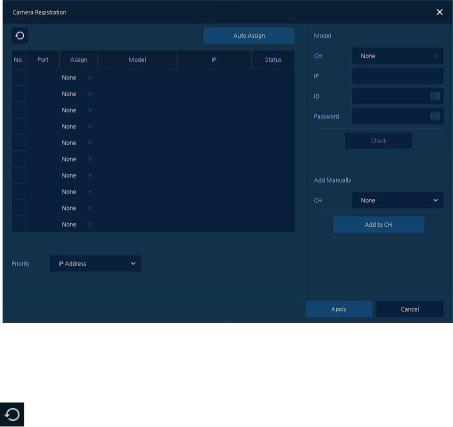
|
|
Table 3-8 PTZ Control Item and Description in Quick menu |
|
|
|
No. |
Item |
Description |
|
|
|
1 |
Preset Go |
Run selected Preset number. |
|
|
|
2 |
Preset Save |
Save specific positions of the camera, at most 255 settings. |
|
|
|
3 |
Tour Go |
Run Tour function. |
|
|
|
4 |
Tour Save |
Save multiple preset positions to run each position in order. |
|
|
|
5 |
Scan Go |
Run Scan function. |
|
|
|
6 |
Pattern Go |
Run Pattern function. |
|
|
|
7 |
Exit |
Exit to live screen menu in PTZ Control menu. |
|
|
|
3.3.2Camera Registration
Users can register the IP cameras.
|
|
Figure 3-10 Camera Registration |
|
|
Table 3-9 Camera Registration |
|
|
|
No. |
Item |
Description |
|
|
|
1 |
|
Search the connected IP cameras. |
|
|
|
2 |
Auto Assign |
Automatically assign the channel windows. |
|
|
|
3 |
Port |
Show the detected camera port (WAN, PoE). |
|
|
|
4 |
Assign |
Selecting the channel windows manually. |
|
|
|
5 |
Model |
Show detected camera model number. |
|
|
|
6 |
IP |
Show detected camera IP address. |
|
|
|

No. |
|
Item |
|
|
Description |
|
|
|
|
|
|
7 |
|
Status |
|
Show connection status. |
|
|
|
|
|
|
|
8 |
|
Priority |
|
Select IP Address or Zero conf IP. When camera have IP address and zero |
|
|
|
conf IP, NVR display selected priority address. |
|||
|
|
|
|
||
|
|
|
|
|
|
9 |
|
Add Manually |
|
Select channel and click |
to open manual add window. |
|
|
|
|
|
|
Add Manually
Click  to open Camera Registration. Or move mouse point at the middle of channel window on the live screen and click
to open Camera Registration. Or move mouse point at the middle of channel window on the live screen and click  .
.
|
|
Figure 3-11 Camera Registration (manual add) |
|
|
Table 3-10 Camera Registration (manual add) |
|
|
|
No. |
Item |
Description |
|
|
|
1 |
Connection Mode |
Select connection mode as Onvif or RTSP. |
|
|
|
2 |
ID/PWD |
Enter ID and password of IP camera. |
|
|
|
3 |
Onvif URL |
Enter camera IP address. |
|
|
|
4 |
RTSP URL |
Enter Primary and Secondary RTSP IP address and URL. |
|
|
|
5 |
Onvif Port |
Enter web port. Default port is 80. |
|
|
|
6 |
RTSP Port |
Enter RTSP port. Default port is 554. |
|
|
|
7 |
Mode |
Select video stream format (RTSP/HTTP). |
|
|
|
3.3.3Status > System log
Users can see the system log information in System log tap in Status screen.
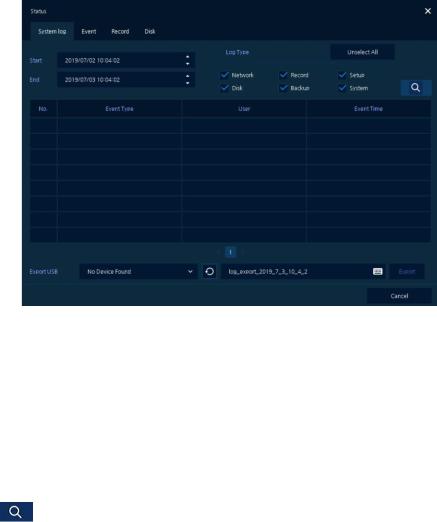
|
|
|
|
Figure 3-12 Status > System log in Quick menu |
|
|
Table 3-11 Status of Quick menu > System log Item and Description |
||
|
|
|
|
|
No. |
|
Item |
|
Description |
|
|
|
|
|
1 |
|
Start |
|
Setting starting time of system log to search. |
|
|
|
|
|
2 |
|
End |
|
Setting ending time of system log to search. |
|
|
|
|
|
3 |
|
Log Type |
|
Selecting log types (Network, Record, Setup, Disk, Backup, and System) |
|
|
|
|
|
4 |
|
Select All |
|
Selecting or clearing all log types (toggle). |
|
/Unselect All |
|
||
|
|
|
|
|
|
|
|
|
|
5 |
|
|
|
Pressing search button search on the basis of set condition. |
|
|
|
|
|
6 |
|
System log list |
|
Displaying system log lists. |
|
|
|
|
|
7 |
|
Export USB |
|
Export the log data to USB thumb drive. File format is csv. |
|
|
|
|
|
8 |
|
Cancel |
|
Completing the status screen. |
|
|
|
|
|
